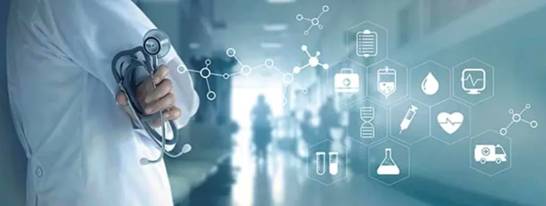Wearable devices support high-quality development of the healthcare industry
Time:2023-10-02
Views:640

Source: PopTika/Shutterstock.com
COVID-19 makes people realize the importance of timely medical data to help identify vulnerable and high-risk groups. Prior to the COVID-19 pandemic, medical wearable and other connected medical devices were already able to provide long-term data needed to alert potential health issues. After the end of this epidemic, wearable devices are likely to play a greater role in the healthcare sector. By providing continuously updated measurements of key vital signs, wearable devices will help shorten treatment time, reduce the need for medical staff to perform necessary but time-consuming measurement work, and enable them to focus on patient care. Here, we will explore how wearable devices can provide long-term effective solutions to provide healthcare professionals with the necessary patient basic data.
The importance of vital sign monitoring
Vital sign monitoring usually allows healthcare professionals to quickly understand patients‘ symptoms or chronic health issues. Therefore, for decades, it has been necessary to measure an individual‘s main vital signs, including body temperature, pulse, respiratory rate, and blood pressure, before entering a doctor‘s office, clinic, or hospital for medical treatment. In certain health conditions, other physiological indicators such as peripheral blood oxygen saturation (SpO2) have become increasingly important and have been included in the measurement range of vital signs.
Doctors with solid professional training and clinical experience can identify potential pathological issues through changes in key vital signs or abnormal readings, including:
Body temperature can reflect the immune system‘s response to infections or other conditions.
Heart rate can help identify potential heart problems.
Monitoring vital signs with wearable technology
For each vital sign, wearable technology has been or will be launched on the market to conduct long-term and regular vital sign monitoring as needed. For example, temperature wearable devices that have been widely adopted by hospitals, especially in many neonatal wards, allow infants to wear micro wireless temperature sensor patches, allowing medical staff to monitor body temperature without disturbing other small patients.
The smart watch and fitness bracelet with a built-in heart rate monitor (HRM) not only provide users with basic heart rate measurement, but also serve as an advanced technical foundation for detecting other health issues. Digital health technology startups Cardiogram and the University of California, San Francisco (UCSF) conducted research using heart rate data provided by HRM smartwatches and found that even conventional heart rate data can provide detection of atrial fibrillation or other arrhythmias. Their further research found that heart rate data can provide early indicators of diabetes or pre diabetes status. Other types of heart rate data analysis can also provide heart rate variability (HRV) measurements to identify physiological and pathological (such as cardiovascular disease) and psychological (such as anxiety or depression) issues that can affect health and life.
Other analytical techniques can also obtain SpO2, respiratory rate, and blood pressure data using optical sensors of the same type used in HRM smartwatches and fitness wearable devices, without the need for separate pulse oximeter clips, respiratory chest straps, or blood pressure cuffs. Similarly, other wearable and measurement technologies can also generate electrocardiograms with sufficient resolution to alert doctors to the need for more in-depth examinations.
In the long run, wearable devices can also help ensure that patients who do not need to go to clinics or even enjoy large-scale medical equipment diagnosis and treatment services at home comply with medical advice. In fact, even though some wearable medical devices often experience variability and reduced resolution in their measurements, their data can still provide early warning for medical service personnel.
Respiratory rate reflects the overall cardiovascular health status and provides particularly important indicators for possible cardiovascular problems.
Blood pressure reflects cardiovascular health and various other diseases.
With the development of the COVID-19 coronavirus epidemic, vital sign monitoring has become particularly important. Medical staff have found that the infection of the SARS COV-2 virus that caused this epidemic can induce an immune response in the body, leading to an increase in body temperature. Therefore, fever is considered a relatively reliable COVID-19 predictor and is widely used as a rapid and primary means of screening for suspected cases. In fact, for those who are considered high-risk due to age, chronic health issues, or potential immune system damage, regular monitoring of vital signs remains crucial.
For patients infected with SARS-CoV-2, doctors need to monitor a series of vital signs to observe the progression of COVID-19 disease. For example, SpO2 measurement is crucial for detecting a decrease in blood oxygen saturation, which is closely related to the harm this virus poses to the respiratory system. Patients with COVID-19 experience a decrease in blood oxygen saturation and an increase in respiratory rate as the cardiovascular system attempts to obtain more oxygen. Due to the serious impact of the further development of diseases on human health, it is crucial to regularly monitor the vital signs of patients.

Utilizing key supporting technologies to enhance healthcare monitoring
Advanced sensor technology and complex analysis methods are only a part of the wearable healthcare puzzle, and many other technologies are needed to support continuous vital sign monitoring. Wearable developers can leverage a wide range of wireless connectivity solutions, including microcontrollers using integrated wireless electronic systems to provide Bluetooth 5 and other connectivity.
Wearable devices can adopt standard security mechanisms to provide a high level of data confidentiality and integrity for the medical data chain. Wearable devices based on wireless microcontrollers can securely send medical data to mobile devices, local networks, and even the cloud. These Bluetooth devices also provide a foundation for contact tracking algorithms to avoid endangering personal privacy or security during COVID-19 outbreaks. The functionality and performance of these Bluetooth devices and other ultra-low power devices can support more complex medical algorithms without affecting the limited power budget of battery powered products.
epilogue
Wearable devices are small in size and comfortable to wear, able to perform unobtrusive measurements at the update speed and measurement duration required by doctors, without further burdening medical staff. Fortunately, for those who are helping humanity recover from the pandemic and seeking long-term effective solutions to improve human health and well-being, existing underlying wearable technologies and analytical capabilities can be utilized to promote the development of the healthcare industry.

Stephen Evanczuk
Author Introduction
Stephen Evanczuk has over 20 years of writing experience in the electronics industry, covering a wide range of topics, including hardware, software, systems, and IoT applications. He obtained a doctoral degree in neural network neuroscience and engaged in research on large-scale distributed security systems and algorithm acceleration methods in the aerospace industry. At present, in his spare time writing articles on technology and engineering, he is still researching the application of deep learning in recognition and recommendation systems.
About Maoze Electronics
Mouser Electronics is a globally authorized distributor of semiconductors and electronic components, serving the vast global electronic design community. The original factory of Maoze Electronics authorizes the distribution of nearly 1200 well-known brands, with the ability to order millions of online products, providing customers with a one-stop procurement platform. Welcome to follow us and obtain first-hand design and industry information!
|
Disclaimer: This article is transferred from other platforms and does not represent the views and positions of this site. If there is any infringement or objection, please contact us to delete it. thank you! |











